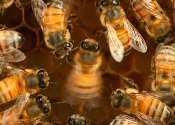Hacking animal communication with AI
Ever wonder what birds are talking about? Does eavesdropping on bees sound intriguing? Want to know what your cat really thinks of you?

Ever wonder what birds are talking about? Does eavesdropping on bees sound intriguing? Want to know what your cat really thinks of you?

Passing down shared knowledge from one generation to the next is a hallmark of culture and allows animals to rapidly adapt to a changing environment.
Plants & Animals
Mar 9, 2023
5
192

(PhysOrg.com) -- Authorities in Toulouse in the south-west of France are considering a proposal to install "pavement power" technology that would use the energy provided by pedestrians to generate electricity to run the street ...

Scientists have discovered how honeybees can decipher dances by their hive mates that relay directions to food. The findings, published in Current Biology, reveal how, in the complete darkness of the hive, each bee uses its ...
Plants & Animals
Mar 13, 2024
0
131

A pair of veterinary medicine specialists at the University of Glasgow has found that the famous dancing monkeys of Pakistan have highly elevated levels of stress hormones. In their study, published in the journal Applied ...

Human influences have the potential to reduce the effectivity of communication in bees, adding further stress to struggling colonies, according to new analysis.
Plants & Animals
Jun 5, 2023
0
48

Researchers from the Xishuangbanna Tropical Botanical Garden (XTBG) of the Chinese Academy of Sciences and the University of California San Diego have revealed that receiving an inhibitory signal (stop signal) associated ...
Ecology
Apr 13, 2023
0
39

In a study published in PNAS, researchers from the Xishuangbanna Tropical Botanical Garden (XTBG) of the Chinese Academy of Sciences, Freie Universität Berlin and Rutgers University showed that the dance of the returning ...
Plants & Animals
Mar 15, 2023
0
19

Electronic music lovers know the drill: as soon as the DJ turns up the bass, the crowd goes wild and dances with heightened enthusiasm. But to what extent is this a conscious reaction?
Other
Nov 8, 2022
0
857

Music, dance, art and storytelling have allowed an international team of researchers to reveal aspects of air pollution in Nairobi that would not have been identified otherwise.
Environment
Dec 3, 2021
1
91
Dance is an art form that generally refers to movement of the body, usually rhythmic and to music, used as a form of expression, social interaction or presented in a spiritual or performance setting.
Dance may also be regarded as a form of nonverbal communication between humans, and is also performed by other animals (bee dance, patterns of behaviour such as a mating dance). Gymnastics, figure skating and synchronized swimming are sports that incorporate dance, while martial arts kata are often compared to dances. Motion in ordinarily inanimate objects may also be described as dances (the leaves danced in the wind).
Definitions of what constitutes dance are dependent on social, cultural, aesthetic, artistic and moral constraints and range from functional movement (such as folk dance) to virtuoso techniques such as ballet. Dance can be participatory, social or performed for an audience. It can also be ceremonial, competitive or erotic. Dance movements may be without significance in themselves, such as in ballet or European folk dance, or have a gestural vocabulary/symbolic system as in many Asian dances. Dance can embody or express ideas, emotions or tell a story.
Dancing has evolved many styles. Breakdancing and Krumping are related to the hip hop culture. African dance is interpretative. Ballet, Ballroom, Waltz, and Tango are classical styles of dance while Square Dance and the Electric Slide are forms of step dances.
Every dance, no matter what style, has something in common. It not only involves flexibility and body movement, but also physics. If the proper physics are not taken into consideration, injuries may occur.
Choreography is the art of creating dances. The person who creates (i.e., choreographs) a dance is known as the choreographer.
This text uses material from Wikipedia, licensed under CC BY-SA